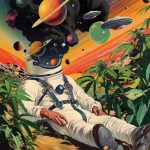Orangutan Uses Self-Made Medicinal Salve to Heal Wound
Wild Orangutan Takes Matters into His Own Hands
Biologists from the Max Planck Institute of Animal Behavior, Konstanz, Germany and Universitas Nasional, Indonesia were stunned when they witnessed a large male orangutan self-medicating with a paste of chewed up plants to heal a large wound on his cheek. This groundbreaking behavior was observed for the first time by scientists and published in a peer-reviewed study in Scientific Reports.
In 2022, the biologists first saw the behavior in Rakus, an orangutan living in Gunung Leuser National Park in Sumatra. Rakus had a gaping wound on his cheek and instead of waiting for it to heal on its own, he took matters into his own hands and behaved in a way that has never been seen before in a non-human.
Lead researcher Dr. Isabelle Laumer, a primatologist and behavioral biologist, confirmed the findings to High Times. “We observed a male Sumatran orangutan (Pongo abelii) who sustained a facial wound,” the researchers wrote. “Three days after the injury he selectively ripped off leaves of a liana with the common name Akar Kuning (Fibraurea tinctoria), chewed on them, and then repeatedly applied the resulting juice onto the facial wound. As a last step, he fully covered the wound with the chewed leaves.” The researchers saw no signs of infection and the wound closed within five days. After a month, Rakus’s wound was fully healed.
The plant used by the orangutan, Fibraurea tinctoria, has anti-inflammatory and antibacterial properties and is commonly used by humans to treat malaria and diabetes. While humans have been using medicinal salves for thousands of years, this behavior is rarely seen in wild animals.
Dr. Caroline Schuppli, a senior author of the paper, told the Natural History Museum, “The treatment of human wounds was most likely first mentioned in a medical manuscript that dates back to 2200 BC, which included the cleaning, plastering, and bandaging of wounds with certain wound care substances. As African and Asian great apes have also been seen actively treating wounds, it is possible we share a common underlying mechanism for recognizing and applying medical substances to wounds. This might have developed in a common ancestor, which may have already showed similar forms of ointment behavior.” (Laumer et al., 2024 Scientific Reports)
According to CBS News, gorillas, chimpanzees, and bonobos have also been observed using bitter-tasting leaves to get rid of stomach parasites. The rough texture of the leaves can scrape out their digestive systems. The apes only eat these types of leaves when they need help with their digestive tracts.
These findings not only shed light on the intelligence and resourcefulness of orangutans, but also suggest that humans and great apes may share a common ancestor with a similar understanding of medicinal substances. It’s clear that we have much to learn from our closest relatives in the animal kingdom.






